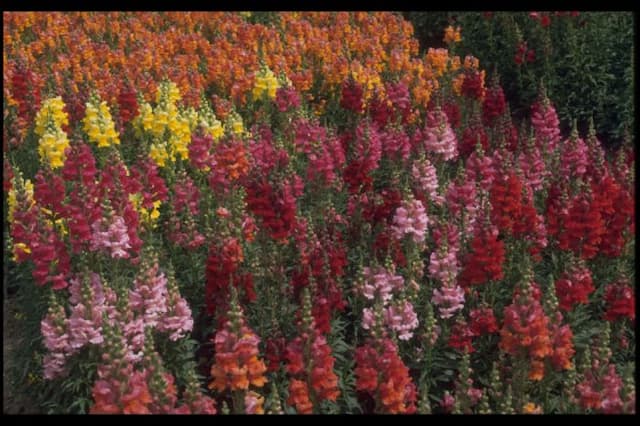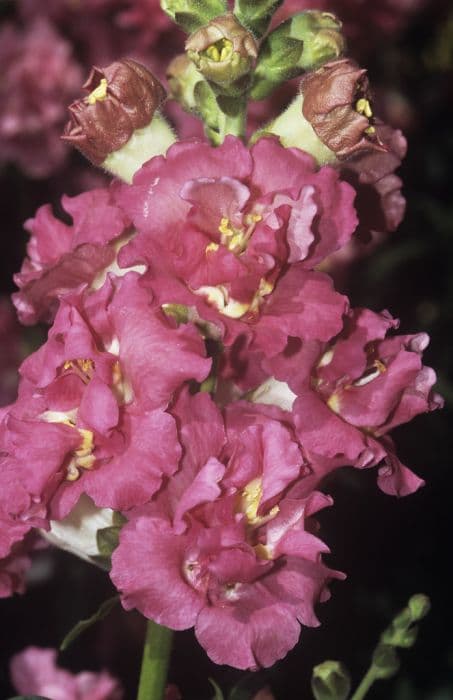Beardtongue Penstemon 'Hewell Pink Bedder'

ABOUT
The Penstemon 'Hewell Pink Bedder', also known simply as Beardtongue, presents a striking display of vivid floral beauty that is a delightful addition to any garden. This plant is primarily recognized for its tubular flowers, which exhibit a gorgeous shade of pink that is both soft and eye-catching. These flowers are neatly arranged in panicles that gracefully rise above the foliage, presenting a look that is both elegant and vibrant. The foliage of Beardtongue consists of narrow leaves that are lance-shaped with a smooth texture and a deep green color. These leaves provide a perfect backdrop for the pink blossoms, contributing to the plant's overall lush appearance. As the flowers bloom, their open mouths reveal a contrasting white throat with delicate streaks or markings that can vary in color, adding depth and a unique character to each individual flower. The robust nature of this Beardtongue variety ensures that it produces a bountiful display of blossoms that can last throughout the blooming season, attracting pollinators like bees, butterflies, and hummingbirds to the garden. With its charming pink blooms and contrasting foliage, Penstemon 'Hewell Pink Bedder' adds a touch of whimsy and a dash of color to any planting space where it is featured.
About this plant
 Names
NamesFamily
Plantaginaceae
Synonyms
Beard Tongue, Beardtongue
Common names
Penstemon 'Hewell Pink Bedder'
 Toxicity
ToxicityTo humans
The Beardtongue is generally considered non-toxic to humans. Ingesting any part of the plant is unlikely to result in poisoning or serious consequences. However, as with any plant, individual allergies or sensitivities could occur, so it's always wise to exercise caution and keep plants out of reach of children who might accidentally ingest plant material.
To pets
The Beardtongue is also generally regarded as non-toxic to pets. Pets that consume any part of this plant are unlikely to experience poisoning or severe health issues. Nonetheless, it's still a good practice to monitor your pets and prevent them from eating plants, as individual reactions can vary, and over-consumption of non-food items can cause gastrointestinal upset.
 Characteristics
CharacteristicsLife cycle
Perennials
Foliage type
Deciduous
Color of leaves
Green
Flower color
Pink
Height
2 feet (60 cm)
Spread
2 feet (60 cm)
Plant type
Herb
Hardiness zones
8
Native area
North America
Benefits
 General Benefits
General Benefits- Attracts Pollinators: The nectar-rich flowers of the Beardtongue are known to attract bees, butterflies, and hummingbirds, contributing to a healthy and vibrant garden ecosystem.
- Low Maintenance: Beardtongue is a hardy plant that requires minimal care once established, making it ideal for gardeners looking for low-maintenance options.
- Drought Tolerance: This plant is well-adapted to drier conditions and can thrive with less water, making it suitable for water-wise landscaping.
- Aesthetic Appeal: With its attractive pink blooms, the Beardtongue adds color and beauty to garden beds, borders, and containers.
- Long Blooming Season: The Beardtongue typically has a long flowering period, providing visual interest throughout much of the growing season.
- Versatile Landscaping: This plant can be used in a variety of garden designs, including rock gardens, perennial borders, and wildflower meadows.
- Erosion Control: Beardtongue's root system can help stabilize soil and prevent erosion on slopes and in areas with loose soil.
- Wildlife Habitat: By providing nectar and habitat, Beardtongue can contribute to supporting local wildlife populations.
- Adaptability: Beardtongue plants can adapt to a range of soil types, from loamy to sandy and even somewhat clayey conditions.
- Resists Deer: The plant is not typically favored by deer, which can help to reduce damage in gardens where deer browsing is a problem.
 Medical Properties
Medical PropertiesThis plant is not used for medical purposes.
 Air-purifying Qualities
Air-purifying QualitiesThis plant is not specifically known for air purifying qualities.
 Other Uses
Other Uses- Photography: Penstemon flowers, including 'Hewell Pink Bedder', are often used in macro photography due to their vibrant colors and intricate details.
- Educational tool: Educators can use this plant to demonstrate pollination biology and plant-animal interactions due to its attraction of pollinators like bees and hummingbirds.
- Artistic inspiration: Their striking appearance makes them a favorite among artists and illustrators needing inspiration for botanical art.
- Dye production: Historically, pigments derived from vibrant flowers like Penstemon have been used for natural fabric dyes.
- Event decoration: Penstemon 'Hewell Pink Bedder' can be used for adding a splash of color to events or ceremonies without the need for artificial decorations.
- Culinary presentation: The flowers can be used as edible garnishes on plates, offering a floral touch to gourmet dishes, provided they haven't been treated with chemicals.
- Garden competition: Gardeners can use Penstemon varieties to participate in horticultural shows or garden competitions, showcasing their cultivation skills.
- Erosion control: Penstemon plants can help stabilize soil in garden landscapes that are prone to erosion.
- Theme gardens: They can be included in a 'pink theme' garden where all plants feature various shades of pink, creating a cohesive visual effect.
- Photoperiod studies: Penstemon can be used in botanical studies to investigate the effect of light periods on flowering patterns in temperate plant species.
Interesting Facts
 Feng Shui
Feng ShuiThe Beard Tongue is not used in Feng Shui practice.
 Zodiac Sign Compitability
Zodiac Sign CompitabilityThe Beard Tongue is not used in astrology practice.
 Plant Symbolism
Plant Symbolism- Perseverance: The hardy nature of the Penstemon, often thriving in challenging environments, symbolizes the ability to endure and persist through difficulties.
- Diversity: With numerous species in its family, Penstemon represents variation and the embrace of uniqueness.
- Elegance: The Penstemon's long, tubular flowers and attractive hues embody grace and sophistication.
- Health: As many Penstemon species are used in traditional medicine, they can be associated with healing and well-being.
- Attraction: The bright colors of the 'Hewell Pink Bedder' variety in particular can symbolize allure and the power of attractiveness to bring joy.
 Water
WaterBeardtongues need regular watering, especially during their first growing season to establish a deep, extensive root system. Once established, they are relatively drought-resistant, so they can be watered deeply, less frequently. Provide about 1 inch of water per week, which translates to roughly 0.623 gallons for an average-sized plant. During particularly hot or dry weather, increase water to twice per week. Avoid overhead watering to prevent leaf and stem diseases, concentrating instead on the soil level.
 Light
LightBeardtongues thrive in full sun, which means they need at least 6 to 8 hours of direct sunlight per day. Planting them in a spot that receives ample morning sunlight and some protection from the intense afternoon sun is ideal, especially in very hot climates. They can tolerate partial shade, but flowering will be reduced in less than full sun conditions.
 Temperature
TemperatureBeardtongues are best suited to temperate climates and can typically tolerate a range of temperatures once established. They can survive in temperatures as low as 20°F and as high as 90°F, but the ideal temperature for growing beardtongues is between 50°F and 85°F. They are not well-suited to extreme cold and may need protection if temperatures are likely to dip below the 20°F threshold.
 Pruning
PruningPruning beardtongues helps to encourage bushier growth and more blooms. Deadhead spent flowers regularly to prolong blooming. After the first killing frost, cut back the stems to an inch or two above the soil line. This can also be done in early spring if preferred. Pruning annually will maintain the plant's shape and promote more vigorous growth for the upcoming season.
 Cleaning
CleaningAs needed
 Soil
SoilBeardtongue prefers a soil mix with good drainage, consisting of loamy soil enriched with organic matter. Aim for a pH range between 6.0 and 8.0. A combination of two parts garden soil, one part well-rotted compost, and one part perlite or coarse sand is ideal to facilitate adequate drainage and aeration.
 Repotting
RepottingBeardtongue does not need frequent repotting and can typically be repotted every 2-3 years. It's crucial to repot when you notice signs of the plant outgrowing its current container or the soil becoming compacted.
 Humidity & Misting
Humidity & MistingBeardtongue prefers moderate humidity levels but is fairly adaptable to various conditions. Ensuring good air circulation around the plant will help mimic its natural environment, negating the need for specific humidity adjustments.
 Suitable locations
Suitable locationsIndoor
Ensure bright light, well-draining soil, and avoid overwatering.
Outdoor
Plant in well-drained soil, full sun to part shade, and water moderately.
Hardiness zone
4-9 USDA
 Life cycle
Life cycleThe Penstemon 'Hewell Pink Bedder' begins its life cycle as a seed, requiring stratification or exposure to cold before it will germinate in spring. After germination, the seedling grows into a young vegetative plant, developing a rosette of leaves at ground level. As it matures, it develops a strong root system and produces upright stems with lance-shaped leaves. The next stage is flowering, typically occurring in late spring to early summer, where the plant displays dense clusters of tubular pink flowers that are attractive to bees and hummingbirds. Following pollination, the flowers develop into small capsules containing numerous seeds. The plant may die back in colder climates during winter but can be a perennial in warmer regions, regrowing from the root system the following spring.
 Propogation
PropogationPropogation time
Spring-Early Summer
The Penstemon 'Hewell Pink Bedder', commonly known as beardtongue, is generally propagated through stem cuttings which is a popular and effective method for this particular species. The best time to take cuttings for propagation is in late spring to early summer when the plant is actively growing. Choose healthy, non-flowering stems for the best success. Cut a stem that is about 3-4 inches (about 7.5-10 cm) long, just below a node, and remove the lower leaves. Dip the cut end in rooting hormone to encourage root growth, then insert the cutting into a pot filled with a moistened mixture of perlite and peat moss. Cover the pot with a plastic bag or place it in a propagator to maintain humidity, and place in indirect light. Keep the soil moist but not waterlogged, and in a few weeks, the cutting should root and be ready for transplanting.





![Snapdragon [Pretty in Pink]](/_next/image?url=https%3A%2F%2Fplants-admin.emdemapps.com%2Fimages%2Fplants%2F%2Fimages%2F604b5cb3b5385.png&w=640&q=75)



